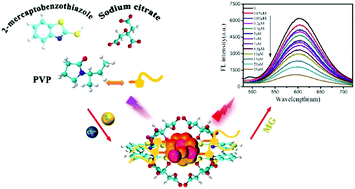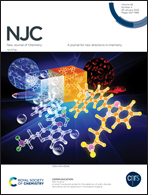PVP–gold–copper nanocluster based NIR fluorescence probe for sensitive detection of malachite green†
Abstract
Malachite green (MG) is considered an environmental contaminant because of its antifungal, carcinogenic and teratogenic properties. The existing detection methods of MG are complex, costly and laborious. In this study, a simple and cost-effective method of MG detection has been developed and successfully applied to aquatic products through constructing a fluorescent sensor based on stable polyethylene pyrrolidone–gold–copper nanoclusters (PVP–Au/CuNCs). PVP–Au/CuNCs were synthesized with 2-mercaptobenzothiazole (MBT) as a protective agent at room temperature. The prepared PVP–Au/CuNCs demonstrated bright red fluorescence and excitation/emission peaks at 390/605 nm, and the fluorescence intensity of the PVP–Au/CuNCs can change when mixed with MG. The quenching effect of MG towards the PVP–Au/CuNCs can be attributed to the electron transfer between MG and MBT, causing the PVP–Au/CuNCs to lose protection from MBT, further resulting in fluorescence resonance energy transfer (FRET) between MG and the PVP–Au/CuNCs. The proposed sensor exhibited good selectivity with a wide linear range from 0.05 to 25 μM for the determination of MG, and the corresponding detection limit is found to be 16 nM (S/N = 3), so it could be a good alternative to existing MG detection methods.



 Please wait while we load your content...
Please wait while we load your content...